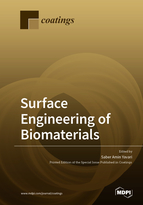Surface Engineering of Biomaterials
A special issue of Coatings (ISSN 2079-6412).
Deadline for manuscript submissions: closed (20 October 2018) | Viewed by 26891
Special Issue Editor
Interests: surface bio-functionalization; additive manufacturing and prevention of implant failures
Special Issues, Collections and Topics in MDPI journals
Special Issue Information
Dear Colleagues,
Acceptance or rejection of implanted biomaterials is strongly dependent on an appropriate bio-interface between the biomaterial and its surrounding tissue. Given the fact that most bulk materials only provide mechanical stability for the implant and may not interact with tissues and fluids in vivo, surface modification and engineering of biomaterials plays a significant role towards addressing major clinical issues such as lack of osseointegration and implant associated infections. It has been recently demonstrated that altering surface properties including physiochemical, topographical, and mechanical characteristics as well as bio-functionalities is a promising approach for addressing such unmet clinical needs.
Surface engineering of biomaterials could influence the subsequent tissue and cellular events such as protein adsorption, cellular recolonization, adhesion, proliferation, migration, and the inflammatory response. A proper surface treatment should not only retain the excellent bulk properties, in case of metallic implants, such as favourable mechanical properties, good fatigue strength, formability and machinability, but also improve wear and corrosion resistance properties when necessary. Another surface engineering strategy is based on mimicking the complex cell structure and environment or hierarchical nature of the bone. In this case, the design of nano/micrometer patterns and morphologies with control over their properties has been receving the attention of biomaterial scientists due to the promising results for the relevant biomedical applications.
This Special Issue seeks to highlight original research papers or review articles that report on the current state-of-the-art in surface engineering of biomaterials, particularly implants and biomedical devices. The topics of interest include, but are not limited to:
- Mechanical methods:
- Blasting
- Polishing
- Chemical and electrochemical methods:
- Etching
- Alkali treatment
- Anodizing
- Electrophoretic deposition (EPD)
- Chemical vapor deposition (CVD)
- Physical methods:
- Physical vapor deposition (PVD)
- Sputtering
- Plasma Ion implantation and deposition
- Laser or electron beam patterning
- Atomic layer deposition (ALD)
- Plasma electrolyte oxidation (PEO)
- Plasma polymerization
Dr. Saber AminYavari
Guest Editor
Manuscript Submission Information
Manuscripts should be submitted online at www.mdpi.com by registering and logging in to this website. Once you are registered, click here to go to the submission form. Manuscripts can be submitted until the deadline. All submissions that pass pre-check are peer-reviewed. Accepted papers will be published continuously in the journal (as soon as accepted) and will be listed together on the special issue website. Research articles, review articles as well as short communications are invited. For planned papers, a title and short abstract (about 100 words) can be sent to the Editorial Office for announcement on this website.
Submitted manuscripts should not have been published previously, nor be under consideration for publication elsewhere (except conference proceedings papers). All manuscripts are thoroughly refereed through a single-blind peer-review process. A guide for authors and other relevant information for submission of manuscripts is available on the Instructions for Authors page. Coatings is an international peer-reviewed open access monthly journal published by MDPI.
Please visit the Instructions for Authors page before submitting a manuscript. The Article Processing Charge (APC) for publication in this open access journal is 2600 CHF (Swiss Francs). Submitted papers should be well formatted and use good English. Authors may use MDPI's English editing service prior to publication or during author revisions.






